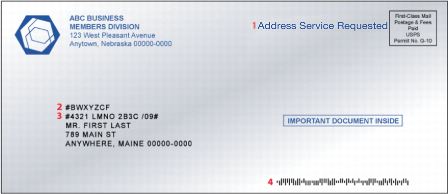A keyline is a unique code that allows mailers to either incorporate existing customer identifiers or create a new system that assists in locating the addressee in their database. Most Traditional ACS participants choose to use the keyline option, which provides an effective means of matching ACS notifications with the appropriate records in their address files.
Although not required to receive COA notices for Traditional ACS, the keyline is required if the mailer wants to receive electronic ACS nixie notices. Nixie notices provide reasons for non-delivery of mail not related to a move (e.g., Vacant, Refused, No Such Number, No Mail Receptacle). Unlike COA notices, which include all applicable customer information, nixie notices do not contain customer name, old address, or new address information. Therefore, the use of a keyline is needed to identify the customer record.
The keyline may consist of 4 to 16 characters including a check digit. Although the content of individual keylines must be unique to ensure identification of a particular customer within a mailer’s address file, all keylines for a given ACS participant code must be consistent in terms of keyline characteristics: length (4 to 16 characters) and attribute (numeric, alpha, or alphanumeric). The same keyline may be used on each piece mailed to the same addressee in multiple mailings.
Exhibit 2: Traditional ACS Mailpiece

- The Ancillary Service Endorsement provides the Postal Service with the sender’s instructions on how to handle the mail if it is UAA.
- The Traditional ACS Participant ID/Code identifies the sender to the Postal Service.
- The Traditional ACS Keyline is delimited by pound signs and identifies the recipient in the sender’s mailing list.
- The Intelligent Mail barcode applied to the mail may contain presort information (flats only), a Service Type Identifier* that requests specific services like ACS and/or IV, a Mailer ID that identifies the mail owner or mail service provider, a serial or sequence number that uniquely identifies the mail piece, and routing information that provides the ZIP Code and delivery point validation that allows the mail to be sorted directly to the address.
* The Service Type Identifier embedded in the Intelligent Mail barcode must be one that specifically requests Traditional ACS.
Technical information on Traditional ACS services is available at https://postalpro.usps.com/address-quality/ACS — scroll down to the section titled “ACS Technical Guides.”
